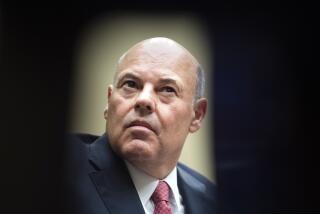What’s behind the postage hike
The postal rate increase that goes into effect today comes at a crucial time for the United States Postal Service.
With Americans increasingly paying bills online and using e-mail for both personal and business correspondence, the Postal Service is facing a steady decline in first-class mail, its most profitable service. At the same time, its labor and fuel costs continue to rise. The changing conditions, Postmaster Gen. John E. Potter told Congress last month, “have challenged us like never before.”
How much are rates going up today?
A first-class stamp is going up from 39 cents to 41 cents; overall, rates are going up 7.6%. One bonus: The new “forever” stamp will be good for first-class postage in the future even after rates go up, so you’ll no longer have to hunt around for extra 2- or 3-cent stamps.
Along with price increases, the Postal Service is introducing “shape-based pricing.” Prices will no longer be determined solely on weight, because the Postal Service wants to encourage consumers and businesses to use envelopes and package sizes that are easier for automated processing.
In a few cases, this actually means price reductions. For instance, a 2-ounce letter in a standard letter-size envelope will cost just 58 cents, less than the old 63 cents. But if that same 2 ounces is put in a 9-inch-by-12-inch envelope it will cost 97 cents.
Didn’t rates just go up last year?
Yes. They went up in January 2006 by 5.4% overall, with a first-class stamp going from 37 cents to 39 cents.
Does the Postal Service make money?
Since its creation in 1971, the Postal Service has been required by law to break even, making just enough to cover its costs. In reality, revenue and expenses never work out evenly in a given year.
In 2006, the Postal Service had a profit of $900 million on revenue of $72.7 billion, its fourth straight profitable year.
But this year the agency is expecting a $5.2-billion loss, largely because Congress has ordered it to start making payments to cover previously unfunded retiree health benefits. For the next 10 years, the Postal Service has to pay more than $5 billion annually toward the health benefits, leading to what Potter described as “a difficult financial situation.”
First-class mail volume has declined by 5.8% since 2001, and in 2003 the number of first-class pieces dropped below half of total Postal Service deliveries for the first time.
Meanwhile, the cheaper standard mail -- mostly advertising -- has been rising and now exceeds first-class mail by almost 5 billion pieces a year. But standard mail is less than half as profitable to the Postal Service as first-class mail.
How does the Postal Service spend its money?
Mostly on labor. With nearly 800,000 employees, the Postal Service is the nation’s third-largest employer, after the Department of Defense and Wal-Mart.
In 2006, 78.6% of the agency’s expenses went to compensation and benefits, compared with just 59.7% for United Parcel Service and 42.9% for Federal Express. The vast majority of postal employees are union members, and average annual pay and benefits for them was $62,348 last year.
The Postal Service has been trying to trim labor spending, dropping 96,000 employees from its payroll since 2001, entirely by attrition. Still, compensation spending has risen every year for the last four years.
“The Postal Service has proven that it is utterly unable to control its labor costs,” said Don Soifer, executive director of the Consumer Postal Council, an independent watchdog.
But postal officials say they’ve spent billions of dollars on technology to automate systems. Potter said the old Post Office Department -- the agency the Postal Service replaced in 1971 -- had nearly as many people as today’s organization but handled less than half as much mail. If not for improved mail handling, today’s Postal Service would have 1.8 million employees, the postmaster general said.
What about fuel prices?
The Postal Service has 216,000 vehicles -- one of the largest fleets in the world -- so rising gas and diesel prices hurt. Every 1-cent increase in the price of gas costs the agency $8 million a year, Potter said.
To reduce its vulnerability to gas price fluctuations, the agency has acquired nearly 40,000 vehicles that are “alternative fuel capable.” But a study by the Government Accountability Office this year found that, because of the cost or unavailability of alternative fuels in many parts of the country, most of these vehicles end up being run on gas or diesel anyway.
Other fuel costs add up too. With more than 34,000 facilities, the Postal Service has more locations than McDonald’s has restaurants worldwide and spends more than $600 million annually on heat and electricity.
What can the Postal Service do to be competitive?
The new Postal Accountability and Enhancement Act, signed into law by President Bush in December, will give the Postal Service something it’s wanted for a long time: greater freedom to adjust prices to market conditions.
In the past, rate increases took 10 months or longer to win approval and go into effect. In fact, today’s rate increase was first requested a year ago last week.
Under the new law, the Postal Service will be able to change postage rates with just 45 days’ notice.
The change comes with one big condition. Rate increases for products in which the Postal Service has a monopoly -- such as first-class mail -- can’t exceed inflation, as determined by the consumer price index.
Potter said working under a rate cap will be “extremely challenging.”
“Significant portions of our costs -- such as fuel and employee retirement and health benefits -- routinely exceed the consumer price index,” he said.
The new law also frees the Postal Service from its “break-even” mandate, a move intended to encourage the agency to operate more efficiently and invest in technological improvements.


